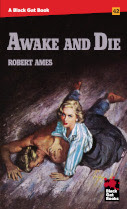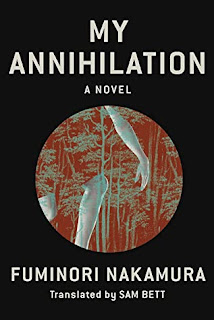Wednesday, December 28, 2022
Bad Kids, by Zijin Chen
Monday, December 26, 2022
coming your way in January: Awake and Die, by Robert Ames
 |
| from Bookscans |
Thursday, July 28, 2022
Death on Gokumon Island, by Seishi Yokomizo
 |
| 1971 cover from Mandarake |
 |
| from TMDB |
The Japanese film (1977) based on this novel (directed by Kon Ichikawa, whose The Burmese Harp I could watch on a continuous loop) starts with the same premise as the book, but for some reason I still can't fathom, the powers that be here then changed the storyline, including the identity of the killer. Also unexpected and producing a very loud "wtf" was a decapitation scene, and I have to say that I actually cringed every time Kindaichi scratched his head releasing clouds of very visible dandruff. Ick. On the other hand, it streamlines the rather convoluted story making it easier to follow, but I'm glad I read the novel before viewing the movie. All in all a fun experience but in my humble opinion, not quite as well done as the movie based on Yokomizo's Inugami Clan, also done in the 70s but miles better than this one.
Sunday, June 19, 2022
A Taste for Honey, by H.F. Heard
"The law protects us from the sudden, unpremeditated violence of the untamed blackguard. It is helpless against the calculating malice of a man who patiently and deliberately studies to get around its limitations When you have really faced up to the fact ... that the law, the magistrate and the village policeman are helpless to protect you, then you will be free to consider the unavoidability of step two of doing what we can do."
 |
| movie poster, from filmaffinity |
 |
| MST3K version, my photo |
 |
| Boris Karloff as Mr. Mycroft |
Friday, June 3, 2022
Night Over Fitch's Pond, by Cora Jarrett
There's a moment in the history of any tie between human beings that settles for good the question of who's going to be top dog,"
Tuesday, March 8, 2022
A Puzzle for Fools, by Patrick Quentin
Thursday, February 10, 2022
Back Country, by William Fuller
"Hardbitten veteran of two wars, with a checkered past in which he ran guns from Tangiers to Saudi Arabia and smuggled aliens into the Louisiana marshes from Mexico. Former advertising exec embittered by the blatant infidelity of his ex-wife Dusty. Adventurer who resorts to violence and to skirting, bending or breaking the law when circumstances warrant. Wanderer whose primary ambitions are fishing and 'blue water, sunshine, and freedom..."
He also enjoys classical music and "can talk a little Nietzsche."
 |
| original 1954 cover, from Amazon |
Tuesday, February 1, 2022
The Embezzler, by James M. Cain
 |
| from IMDb |
I would love to watch the film made from this novel in 1940, and I found a place that has transferred it to dvd, mine for only $25. Done, making me a happy person. Unfortunately the shipping was like $45, making me an unhappy person, so I guess I'll wait and hope to find a copy another time.
If you're a fan of James M. Cain's books and want to read beyond the better-known novels, this would be a good place to start; in any case it's much better than his The Cocktail Waitress, which was just sleaze, and not good sleaze at that. This one was just okay.
Monday, January 17, 2022
My Annihilation, by Fuminori Nakamura
"questions about what it means to be human, and what it means to exist in the world,"
"Turn this page, and you may give up your entire life,"
but the narrator reveals that he has "no intention" of giving up his "old life;" all he wants is Kozuka's identity. Noting that while Kozuka may have left some "unfinished business" behind, he assures himself that "it was no business of mine." It's at this point (and we're only on page four) that I realized that it may have been a smart thing to heed that warning, but on into the manuscript he goes.
"... It doesn't even feel like this is me. It's all so blurry, like something shrouded in a distant fog. But evidently somebody is going to take my place. Someone willing to take over for me, accepting all the horrors ... I'm going to be saved."
This bit obviously disturbs the narrator, but only momentarily; continuing on he comes to the story of real-life serial killer Tsutomu Miyazaki, "one of the most infamous criminals in Japan." And while the narrator asks himself "What was all that about?" we know that there are certain things that link both Miyazaki and the author of the manuscript, which I won't mention to avoid spoilers. Yet for our narrator, nothing seems more important at the time than opening that white suitcase, until he is interrupted by the ringing of a bell to his room. That's when things, if not weird enough already, start to take the reader far, far down the rabbit hole.
Without spoiling things for potential readers, what actually emerges here is a sinister plot for revenge, and I must say it's one of the creepiest I've encountered, with the actual mystery behind it all taking a number of surprising twists and turns before all is revealed. Underlying this novel is the answer to the question of "what is a self," to which the author responds that "Under a particular set of circumstances, it becomes impossible to tell." Using various forms of textual material throughout the novel, the author runs with this idea, revealing just how easy it is "to get inside a person's head," an idea at the very heart of this story. He raises questions of identity and memory, especially the ways in which they might be changed or in this case, even created. With that then comes the question of what happens to the original self that must somewhere continue to exist; this sort of philosophical/psychological underpinning is why I noted my reluctance at the outset to define My Annihilation as just another crime novel. At the same time, it moves this book well and deeply into the literary zone, and as the back-cover blurb notes, "into the darkest corners of human consciousness." In short, it's right up my alley.
Monday, January 10, 2022
Act of Darkness, by Francis King
"A slow, expected death has a way of irresistibly sucking the members of a family together down its dark funnel. This death, as violent and unexpected as the explosion following the detonation of a bomb, had the opposite effect of blowing the members of the Thompson family in separate directions, however much they struggled to cling to each other."
The murder also lays bare some of the pent-up frustrations, jealousies and suspicions that have been simmering and chipped away at under the surface within this household. The author absolutely excels here as he traces the effects of this crime on those left behind over the years that follow, offering more than one or two surprising twists as he comes down to its solution.
Sunday, January 2, 2022
The Village of Eight Graves, by Seishi Yokomizo
I'm looking at the date I was last here -- September! Yikes! I have to say that we had an extremely rough 2021 which is actually putting it mildly, but now, thankfully, we've turned that corner and things are much better and slowly getting back to normal going into 2022. I'll be picking up where I left off with the septimo circulo list shortly as well as with a stack of books I've sadly neglected. Truth be told, I'm just glad to be back.
 |
from Amazon Canada. Kosuke Kindaichi action figure. I want one of these!. |












